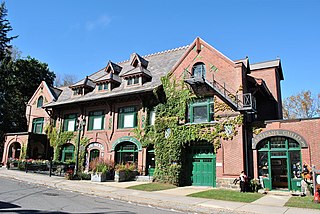
Norfolk is a town in Litchfield County, Connecticut, United States. The population was 1,588 at the 2020 census. The town is part of the Northwest Hills Planning Region. The urban center of the town is the Norfolk census-designated place, with a population of 553 at the 2010 census.

Barrington is a village in Cook County and Lake County, Illinois, United States. The population was 10,722 at the 2020 census. A northwest suburb of Chicago, the area features wetlands, forest preserves, parks, and horse trails in a country-suburban setting.

Barrington Hills is a village located about 40 miles (64 km) northwest of Chicago in the U.S. state of Illinois. Per the 2020 census, the population was 4,114. It straddles approximately 29 square miles (75 km2) over four counties, Cook, Kane, Lake, and McHenry. The Village of Barrington Hills was incorporated in 1957.

Barrington is a suburban, residential town in Bristol County, Rhode Island, United States, located approximately 7 miles (11 km) southeast of Providence. It was founded by Congregationalist separatists from Swansea, Massachusetts, and incorporated in 1717.

A round barn is a historic barn design that could be octagonal, polygonal, or circular in plan. Though round barns were not as popular as some other barn designs, their unique shape makes them noticeable. The years from 1880 to 1920 represent the height of round barn construction. Round barn construction in the United States can be divided into two overlapping eras. The first, the octagonal era, spanned from 1850 to 1900. The second, the true circular era, spanned from 1889 to 1936. The overlap meant that round barns of both types, polygonal and circular, were built during the latter part of the nineteenth century. Numerous round barns in the United States are listed on the National Register of Historic Places.

The University of Illinois Experimental Dairy Farm Historic District, also known as South Farm, is a designated historic district in the U.S. state of Illinois. It is located on the campus of the University of Illinois in Urbana, Illinois. The district consists of eight contributing structures and several non-contributing structures. The district was designated in 1994 when it was added to the National Register of Historic Places as part of the Multiple Property Submission concerning Round Barns in Illinois. Three of the district's buildings are early 20th century round barns constructed between 1908 and 1912. The district covers a total area of 6 acres (2 ha).

Barrington Township is one of 29 townships in Cook County, Illinois, USA. As of the 2020 census, its population was 16,514 and it contained 6,172 housing units. The northwestern corner of the Cook County panhandle, it is the county's northwesternmost township. It is also by far the least densely populated township in the county, with less than half the population density of the next least Lemont Township.

Oxon Cove Park and Oxon Cove Farm is a national historic district that includes a living farm museum operated by the National Park Service, and located at Oxon Hill, Prince George's County, Maryland. It is part of National Capital Parks-East. It was listed on the National Register of Historic Places in 2003.
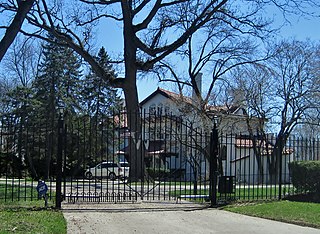
The Frank Hibbard Estate House is a historic house located at 301 North Chiltern Drive in the Deerpath Hill Estates development in Lake Forest, Illinois. The house was built in 1903 for Frank Hibbard of Hibbard, Spencer, Bartlett & Company, which later became True Value Hardware. Architect George Lyon Harvey designed the house in the Mediterranean Revival style; his design featured a terra cotta roof, decorative iron window coverings, and several porches. In 1929, developer Henry Turnbull purchased the property. Turnbull divided the property, which originally occupied a 21-acre (8.5 ha) plot, to create the Second Addition to Deerpath Hill Estates. Architect Stanley Anderson, a colleague of Turnbull and the developer of the original Deerpath Hill Estates, modernized the house in keeping with its Mediterranean design.
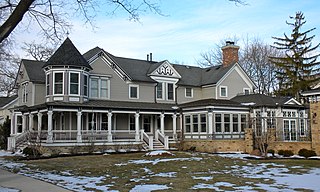
The Barrington Historic District is a 92-acre (37 ha) historic district in Barrington, Illinois. The district encompasses a residential area in southwest Barrington and is roughly bounded by the Chicago and Northwestern Railway tracks to the north, Dundee Avenue to the west, E. Hillside and W. Coolidge Streets to the south, and S. Spring and S. Grove Streets to the east. The large majority of the district is in Cook County, but about one square block is in Lake County, Illinois.
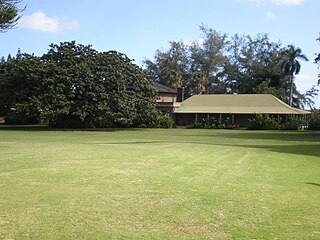
Grove Farm is a historic agricultural site on Kauai in the Hawaiian Islands.
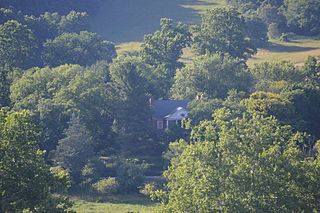
Hickory Hill is a historic estate in Rockbridge County, Virginia.
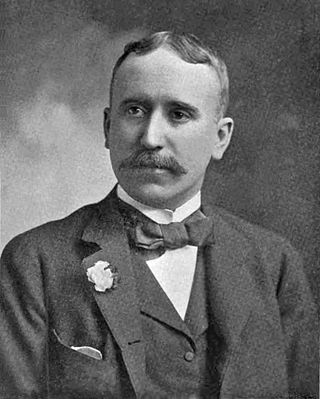
William Grigsby McCormick was an American businessman of the influential McCormick family in Chicago, who was a co-founder of Kappa Sigma Fraternity. He also served as a Chicago alderman.

The Harvey Lee Ross House is a two-story frame, side-gabled house built in approximately 1858 on the farm of Harvey Lee Ross near Vermont, Illinois. The house and several outbuildings were added to the National Register of Historic Places (NRHP) in 1996, based on the distinctive characteristics of the architecture and an association with the life of a significant individual from the past. The house features Greek Revival elements with some Italianate detailing. It was originally owned by Harvey Lee Ross, a railroad developer, banker, merchant, and agriculturist.
The Duvall–Ash Farmstead is a historic farm located northeast of Fiatt in Fulton County, Illinois. Edward Duvall built the farm's oldest buildings, the house and smokehouse, circa 1848. Duvall gave the farmhouse a Gothic Revival design with multiple front-facing gables decorated with bargeboards and topped by finials. In the 1890s, Singleton K. Ash purchased and extensively renovated the farm. Ash placed a Victorian addition on the rear of the house which featured decorative stickwork and bracketing. In addition, Ash and his family built most of the farm's current outbuildings, which include a chicken coop, barns, and storage sheds; these outbuildings form a complete collection of typical outbuildings from an 1890s farm.

The Indian Hill Manor and Farm Historic District is a historic house and farm complex located at 6901-7057 Kishwaukee Road in Rockford, Illinois. The district consists of three parts, all of which were once part of the estate of Charles C. and Esta Barrett: a manor house and coach house, a working farm, and a small forest preserve. Charles, a Chicago businessman, and Esta, an actress and socialite, purchased the property in 1915 with the intent of using it as a rural retreat and gentleman's farm. Rockford architect Charles W. Bradley designed the Colonial Revival manor house and coach house, which were built in 1916–18. Key Colonial features of the design include its rectangular massing, double-hung windows, and classically styled entrance; the house also includes Craftsman elements, such as its low hip roof with overhanging eaves and its exposed ceiling beams in the living and dining rooms. Charles died shortly after the manor house was completed, but Esta lived in the house until she sold it to her son in 1941.
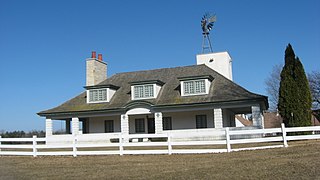
The William McCormick Blair Estate is a historic estate at 982 Sheridan Road in Lake Bluff, Illinois. The estate was built in 1926-28 for financier William McCormick Blair, who was one of the many wealthy and prominent Chicagoans to build an estate in Lake Bluff in the early twentieth century. Architect David Adler, a well-regarded designer of country houses, designed the estate's main house in the Colonial Revival style. The house has a complex, sprawling shape unified by the consistent use of double-hung windows and wood roofing shingles. The estate also includes a garage, a tennis house, two cottages, two sheds, a folly shaped like a Greek temple, a greenhouse, and a garden.
The George E. Van Hagen House is a historic house at 12 W. County Line Road in Barrington Hills, Illinois. The house was built circa 1912 for George Ely Van Hagen, the president of the Standard Forgings Company, and his wife Mary Wakefield Lewis Van Hagen, the granddaughter of President William Henry Harrison. Large country estates in rural suburbs such as Barrington Hills were popular with the wealthy in the early twentieth century; Van Hagen used his house's grounds for a gentleman's farm and fox hunting, typical pastimes of estate owners. Architect John Nyden gave the house an Arts and Crafts style design with Federal Revival elements. The house's design uses the simple geometric forms typical of Arts and Crafts designs throughout, with plain cylindrical columns, diamond and rectangular patterned panels, and semicircular arches atop the entrance and several windows. The Federal Revival elements are largely confined to the interior and include a plasterwork dining room ceiling, a mosaic fireplace surround, and cabinets inspired by Palladian windows.
The Louis Fredrick House is a house designed by Frank Lloyd Wright at 19 W. County Line Road in Barrington, Illinois. The house was built in 1957 for Louis Fredrick, an affluent interior designer. The house's design is typical of Wright's later work, in which he adapted his Usonian design principles to larger homes for wealthier clients. Fredrick played a role in the design process as well, rejecting Wright's original plan on account of its concrete block walls and providing input on decisions such as coloring. The house's design includes a brick exterior, long horizontal window bands, a low roof covered with cedar shakes, and a large chimney.

The Sunderlage Farm Smokehouse is a historic smokehouse at 1775 Vista Walk in Hoffman Estates, Illinois. The smokehouse was built circa 1860 as part of the Sunderlage Farm; it and the farm's farmhouse are the only remaining farm buildings in Hoffman Estates. While the area that is now Hoffman Estates was rural for much of the early nineteenth and early twentieth centuries, its farms were subdivided into suburban housing in the 1960s. The smokehouse, which was used to cure and hold the farm's meat supply, is well-preserved compared to other surviving contemporary smokehouses in northeastern Illinois. Its functional design uses the then-popular Greek Revival style and includes brick detailing below the roof line.




















